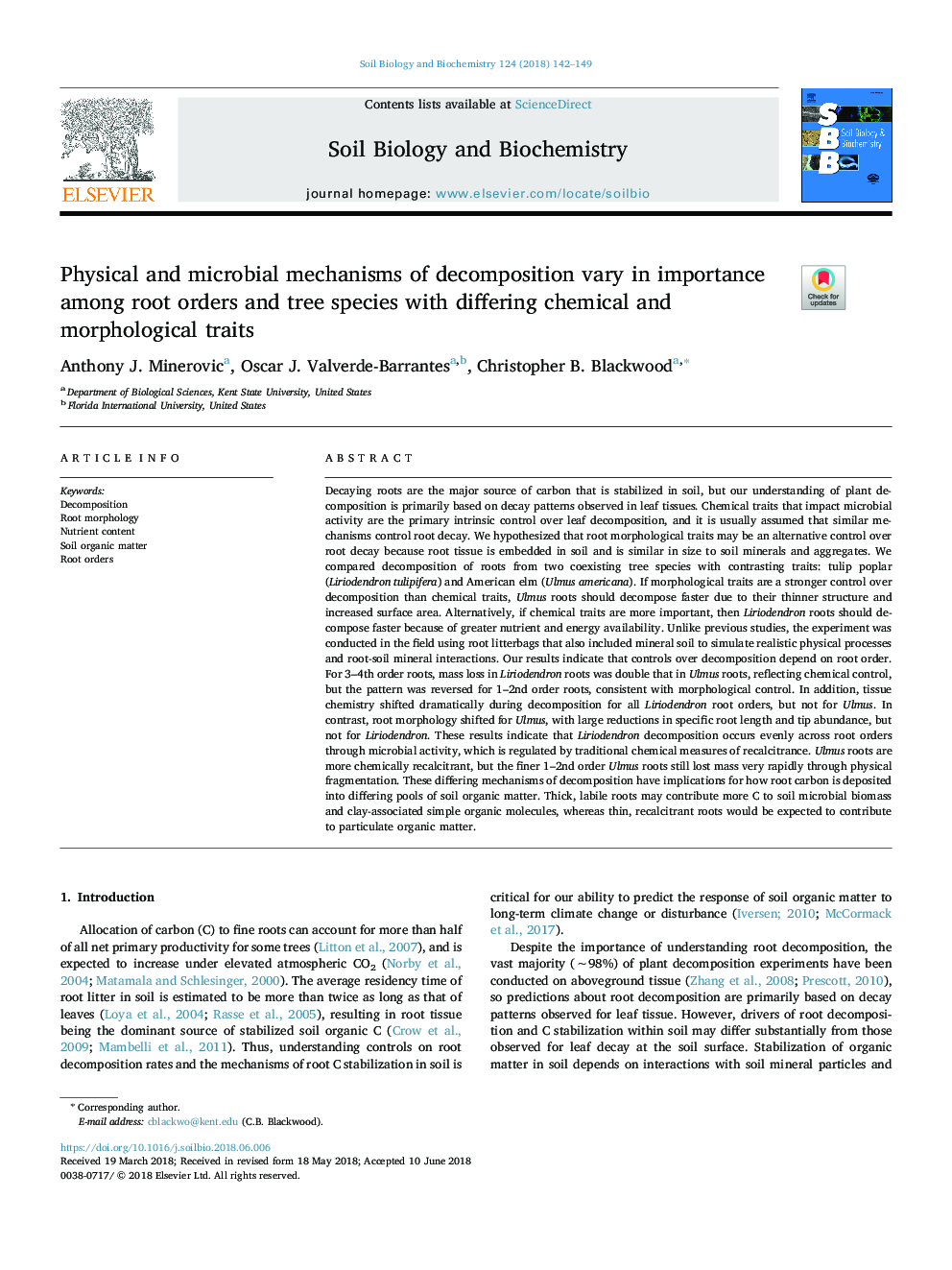| کد مقاله | کد نشریه | سال انتشار | مقاله انگلیسی | نسخه تمام متن |
|---|---|---|---|---|
| 8362566 | 1542560 | 2018 | 8 صفحه PDF | دانلود رایگان |
عنوان انگلیسی مقاله ISI
Physical and microbial mechanisms of decomposition vary in importance among root orders and tree species with differing chemical and morphological traits
ترجمه فارسی عنوان
مکانیزم های فیزیکی و میکروبی تجزیه در اهمیت در میان ریشه ها و گونه های درختی با ویژگی های شیمیایی و مورفولوژیکی متفاوت است
دانلود مقاله + سفارش ترجمه
دانلود مقاله ISI انگلیسی
رایگان برای ایرانیان
کلمات کلیدی
تجزیه، مورفولوژی ریشه، محتوای تغذیه ای ماده آلی خاک، سفارشات ریشه،
موضوعات مرتبط
علوم زیستی و بیوفناوری
علوم کشاورزی و بیولوژیک
دانش خاک شناسی
چکیده انگلیسی
Decaying roots are the major source of carbon that is stabilized in soil, but our understanding of plant decomposition is primarily based on decay patterns observed in leaf tissues. Chemical traits that impact microbial activity are the primary intrinsic control over leaf decomposition, and it is usually assumed that similar mechanisms control root decay. We hypothesized that root morphological traits may be an alternative control over root decay because root tissue is embedded in soil and is similar in size to soil minerals and aggregates. We compared decomposition of roots from two coexisting tree species with contrasting traits: tulip poplar (Liriodendron tulipifera) and American elm (Ulmus americana). If morphological traits are a stronger control over decomposition than chemical traits, Ulmus roots should decompose faster due to their thinner structure and increased surface area. Alternatively, if chemical traits are more important, then Liriodendron roots should decompose faster because of greater nutrient and energy availability. Unlike previous studies, the experiment was conducted in the field using root litterbags that also included mineral soil to simulate realistic physical processes and root-soil mineral interactions. Our results indicate that controls over decomposition depend on root order. For 3-4th order roots, mass loss in Liriodendron roots was double that in Ulmus roots, reflecting chemical control, but the pattern was reversed for 1-2nd order roots, consistent with morphological control. In addition, tissue chemistry shifted dramatically during decomposition for all Liriodendron root orders, but not for Ulmus. In contrast, root morphology shifted for Ulmus, with large reductions in specific root length and tip abundance, but not for Liriodendron. These results indicate that Liriodendron decomposition occurs evenly across root orders through microbial activity, which is regulated by traditional chemical measures of recalcitrance. Ulmus roots are more chemically recalcitrant, but the finer 1-2nd order Ulmus roots still lost mass very rapidly through physical fragmentation. These differing mechanisms of decomposition have implications for how root carbon is deposited into differing pools of soil organic matter. Thick, labile roots may contribute more C to soil microbial biomass and clay-associated simple organic molecules, whereas thin, recalcitrant roots would be expected to contribute to particulate organic matter.
ناشر
Database: Elsevier - ScienceDirect (ساینس دایرکت)
Journal: Soil Biology and Biochemistry - Volume 124, September 2018, Pages 142-149
Journal: Soil Biology and Biochemistry - Volume 124, September 2018, Pages 142-149
نویسندگان
Anthony J. Minerovic, Oscar J. Valverde-Barrantes, Christopher B. Blackwood,
